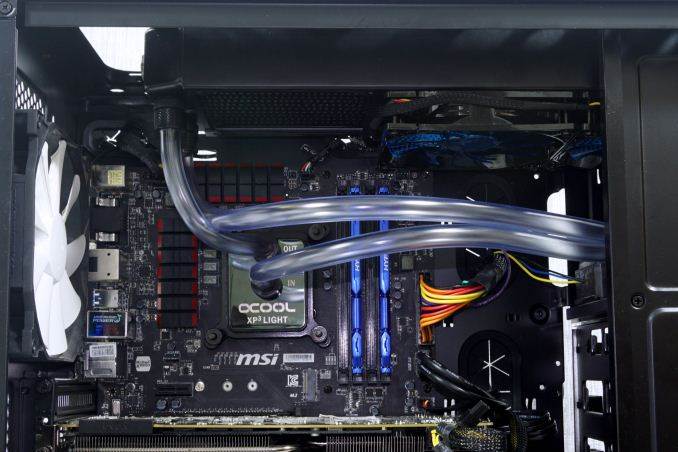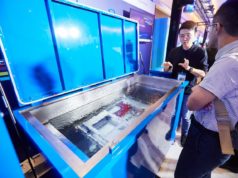Not so long ago, PC liquid cooling was considered to be an extreme approach, one performed by hardcore enthusiasts and overclockers alone. There were no commercial products available and every individual system was designed by the user. Radiators were modified heater cores extracted from cars, CPU blocks were rare and occasionally machined at local workshops using a copper block and a mill, while high-performance tubing came from shops with medical supplies.
As demand grew, aided by the ever-increasing noise of small CPU heatsinks, companies specializing in these “open loop” liquid cooling solutions began turning up — a little too fast perhaps, as tens of companies were founded within a few months’ time and very few of them actually survived for more than a couple of years. Enthusiasts could then buy specialized liquid cooling equipment and even whole kits from just one seller and only had to assemble the setup into their system. That of course is no simple process for an amateur and a nightmare for a system builder, who had to find ways to ship systems pre-filled with coolant or assume that the user has the skills required to fill & maintain such a system. The payoff in terms of cooling was often immense, but the potential market remained limited to advanced users only.
Liquid coolers finally achieved adoption with the wider enthusiast use base at the start of this decade, when the likes of Asetek and CoolIT Systems came up with an inexpensive closed loop solutions, a design was just as simple to install as a common air cooler and required virtually no maintenance at all. However, as convenient as these all-in-one (AIO) solutions may be, hardcore enthusiasts find them lacking and inflexible. Some of the compact AIO designs can hardly compete against air-based solutions in terms of performance. A few companies began making their systems expandable, but the main parts of the system still cannot be upgraded. As such, AIO coolers rarely are acceptable solutions for the most hardcore of enthusiasts and overclockers, who need the best performance and still prefer designing and building their own liquid cooling systems.
Alphacool is a German designer and manufacturer of liquid cooling systems for PCs who has also diversified into producing liquid cooling systems for industrial and medical applications. They are one of the oldest companies in the field and, even though we did have a review of their recent Eisbaer AIO solutions, their specialization lies with the design, manufacturing and supply of high performance liquid cooling parts for advanced PCs.
Except from individual parts, Alphacool also supplies their products as complete pre-tested kits. It is one of these kits that we will be reviewing today, the NexXxoS Cool Answer 360 DDC/XT. The kit includes:
- 1x Alphacool NexXxoS XP3 Light Cooling Block
- 1x Alphacool Repack 5,25 Bay Reservoir
- 1x Laing 12V DDC-1T Pump
- 1x Alphacool NexXxoS XT45 Full Copper Radiator
- 3 meters AlphaTube tubing HF 13/10 (3/8“ID) – clear
- 6x Alphacool HF 13/10 Compression Fittings G1/4
- 3x 120 mm Alphacool Coolmove Fans
- 1x Alphacool CKC Cape Kelvin Catcher Liquid 1000ml
- 1x ATX-bridging plug (24 Pin) – black
Alphacool supplies the NexXxoS Cool Answer 360 DDC/XT kit in a large, very sturdy cardboard box. The artwork is simple, based on pictures of the included parts and basic information about the kit.

Every included part is packed in its own cardboard box, meaning that the exterior box only provides shipping convenience and protection. The packaging of the individual parts, with the exception of the liquid pump, bears the Alphacool company logo. The clear PVC tubing does not have its own packaging, though that would be redundant as it is nearly impossible to damage such an item during transport. Alphacool also supplies a thorough manual.

Except from the block itself, the necessary hardware for the mounting of the block – including a universal backplate and retention brackets for Intel and AMD platforms – can be found inside the packaging of the block. There is also a small syringe with unbranded silver thermal material and instruction manuals.

Alphacool has designed the NexXxoS XP3 Light to be compact and easily adaptable for future platforms. It is very small and lightweight, hardly larger than the CPU socket itself. Two openings for the compression fittings can be seen at the top of the block. The user has to make sure that the flow goes in from the center of the block and out from the edge, otherwise there will be a great loss of performance. Alphacool also includes a very clear notice that no tools should be used for the tightening of the compression fittings, as that can easily damage the plastic threads. Tightening the compression fittings by hand is more than enough.


The base of the NexXxoS XP3 Light is obviously copper. It is well-machined and smooth enough, but Alphacool did not bother polishing it down to a mirror finish. The company likely expects that the experts who would buy such a kit already know that a perfect mirror finish would not actually benefit performance by a measurable amount. Alphacool is also using copper screws in order to prevent chemical oxidation.

The interior of the NexXxoS XP3 Light is relatively simple, yet it is more complex than what an untrained eye might realize. The plastic part forms two H shaped jets that forcefully direct liquid flow towards the copper base. The copper base is practically a thin sheet of copper that has many small traces engraved into it, forming about a thousand mini rectangular pylons. The pressure generated by the jets forces the liquid to move in-between these mini pylons, enhancing heat transfer.

Perhaps the most important part of the system is the massive NexXxoS XT45 radiator. Alphacool supplies it along with mounting and fan screws, as well as with four plugs.

The 360 mm-class XT45 is a massive heat exchanger that measures 400 mm long and 46 mm thick. Its exterior frame is steel, while the chambers and the fins are copper, resulting to a massive weight of 1.4 kg without any parts/fans attached. The paint job of the steel frame is excellent, but it is only superficial on the radiator itself, covering just a bit of the copper chambers. Close inspection reveals that the fins are bare copper.


Alphacool placed not two but six openings for compression fittings, which is why they also supply four plugs alongside with the radiator. The user can select two of the fittings with the most suitable orientation, or even connect more than one loop/system to a single radiator.


The Alphacool Repack is a reservoir designed to fit into a 5.25” external drive bay. This kit includes the DDC version of the reservoir that is designed to be joined with a Laing DDC pump. Although this particular version cannot be used with any other kind of pump, Alphacool offers several versions of this reservoir, including a simple version with compression fittings only.

The Repack is made almost entirely out of clear acrylic. The acrylic is very thick and inflexible, giving the reservoir exceptional overall mechanical strength. Alphacool installs a black metallic plate at the front of the reservoir with their logo, mainly serving as a level meter, but it can be removed if the user wishes. A metallic support plate at the rear of the reservoir is used as a support for the pump.


Two round openings for the pump’s headers and two threaded openings for compression fittings can be seen at the rear of the Repack. Note that the reservoir has internal pathways that separate the incoming and outgoing flows. The left of the compression fittings leads directly to the output of the pump, while the right fitting is for the incoming flow that leads the liquid into the reservoir. Unfortunately, there is no decoupling method for the pump, as it gets attached directly onto the metallic support plate. This transfers all of the vibrations of the pump to the reservoir and, in extension, to the case. Depending on the materials and the quality of the case, this can increase the overall noise output of the system.


The Laing DDC-1T pump is not of Alphacool’s design. Rather the pump is a product of Goulds Water Technology, a Xylem brand, a company that specializes on commercial and industrial pumps. So that the pump could be used inside a PC, Alphacool merely attached a Molex power connector and a 3-pin tachometer sensor.

Although it looks like a very simple plastic apparatus, the DDC-1T is actually one of the best low-voltage DC pumps currently available. It utilizes a hemispherical motor that does not require shaft bearings and/or seals, significantly improving reliability and minimizing noise. The DDC-1T is also very powerful for a 10W device of this size with, according to Alphacool, a maximum discharge head of 3.7 meters and a maximum flow of 420 l/h. Goulds Water Technology states 4.5 m head and 410 l/h respectively in their specifications sheet.

The only downside of the DDC-1T is the narrow voltage operating range. This particular model can only operate with a voltage of 8V to 13.8V (12V maximum for a typical PC) and has a starting voltage of at least 9V, severely limiting its speed control capabilities. This is why Alphacool offers it with a Molex power connector; although your motherboard’s header should not have an issue powering the 10W pump, the company does not expect users to try and speed control it, as it can easily stall and stop if the supplied voltage drops under 8V, or not even start under certain situations.

Although the selection of proper fittings may seem like a mundane task, there are at least a few things that serious water cooling users need to be aware of. The first is the material of the fitting, as certain metals can cause serious corrosion even when using highly anti-corrosive…







